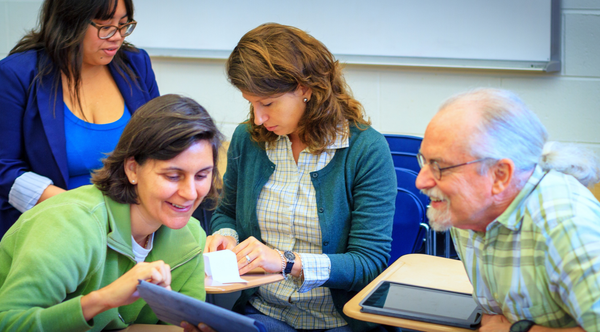An Introduction to Open Educational Resources (OER) and your LMS

As the demand for online learning continues to grow, educators and institutions are turning to Open Educational Resources (OER) to create more flexible, accessible, and cost-effective learning experiences.
OERs are freely accessible, openly licensed educational materials that anyone can use, adapt, and distribute. They allow educators to develop customized learning content that can be easily integrated into Learning Management Systems (LMS) such as Canvas, Brightspace, Blackboard, and Moodle.
Let’s explore digital OERs, their benefits, and how they can be integrated into popular LMS platforms. We also have examples of useful OER resources and best practices for educators looking to leverage these tools in their courses.
What Are Open Educational Resources (OER)?
Open Educational Resources (OER) are educational materials that are freely available for anyone to use, modify, and distribute. They come in many forms, including:
- Textbooks
- Course modules
- Multimedia (videos, podcasts, simulations)
- Assessments and quizzes
- Lecture notes
- Interactive tools and simulations
The defining feature of OERs is their open license, usually a Creative Commons license, which allows educators to reuse and customize materials according to their needs. This flexibility makes OERs particularly valuable in both traditional and online education settings.
Why Use OER in Learning Management Systems (LMS)?
Using OER in an LMS offers several key benefits for educators and students alike:
1. Cost-Effective Learning: Traditional textbooks and course materials can be prohibitively expensive. OERs eliminate these costs, ensuring that all students have access to high-quality learning materials without financial barriers.
2. Customizable Content: Educators can adapt OERs to fit their specific learning outcomes and course requirements. This customization allows for more personalized learning experiences, making it easier to align the content with students' needs or institutional standards.
3. Accessibility and Inclusivity: OERs can be accessed online at any time and often come in multiple formats (text, audio, video), making them suitable for a diverse range of learners. Many OERs are designed to be accessible to individuals with disabilities, further promoting inclusivity.
4. Up-to-Date Information: Because OERs are often digital, they can be updated more frequently than traditional textbooks. This allows educators to ensure that their students are learning from the most current and relevant materials.
5. Collaboration and Sharing: OER encourages a culture of collaboration among educators. Materials can be shared, modified, and improved upon by instructors across institutions, contributing to a more dynamic and innovative learning environment.
Integrating OERs into your LMS
With certain tools, integrating and implementing OERs into your LMS can be straightforward. Through LTI Advantage (1.3), you can gain access to many OER repositories and libraries from a single source without leaving your LMS.
Learning Tools Interoperability (LTI) 1.3 is the only industry educational technology standard that securely connects your institution's LMS with external learning tools, confirms the tool's credentials, and exchanges information in teaching and learning workflow.
This means Atomic Author you can seamlessly find, preview, and embed OER content into your LMS. This enables your educators to leverage course content, content repositories, and OER to create, edit, and embed content into any course, assignment, and assessment with ease.
Working with LMS and OER experts
At Atomic Jolt, we specialize in customizing and implementing Open Educational Resources (OERs) into Learning Management Systems (LMSs) for our clients by offering some key services:
- Integration of OER Content: We can help integrate freely available OER content into your LMS, such as Canvas or Moodle. We can ensure that OER materials like textbooks, videos, or quizzes are compatible with your existing LMS and easily accessible for instructors and students.
- Customization of OER Materials: We can help customize existing OER materials to fit the specific needs of your institution or course. This includes adapting content to match your curriculum, adding institution-specific branding, or creating interactive content.
- Technical Support: We can also offer technical expertise to ensure the seamless operation of OERs in your LMS. We can also help address any challenges, such as file compatibility, platform integration, or functionality issues, ensuring that OERs are optimized for user experience.
- Content Enhancement: In addition to implementation, we’re experienced in enhancing existing OER content by adding multimedia elements, interactive assessments, or data tracking features. This can make the learning process more engaging and personalized for your students.
- Scalability and Maintenance: For institutions looking to scale the use of OERs across multiple courses, we can help ensure the system is robust enough to handle large-scale deployment and provide ongoing maintenance.
By leveraging our industry expertise, institutions can save on content costs while still offering high-quality, customizable educational resources that align with their instructional goals.
Examples of Digital OER Resources
Here are some excellent digital OER resources that can be used across various subjects and LMS platforms:
1. OpenStax
OpenStax provides free, peer-reviewed textbooks for high school and college courses. These textbooks cover subjects ranging from mathematics and science to humanities and social sciences.
OpenStax textbooks can be downloaded in PDF or ePub formats, which can easily be uploaded to any LMS, such as Canvas or Moodle, for student access. Educators can also remix or customize these textbooks to suit their course structure.
2. PhET Interactive Simulations
PhET provides free, interactive science and math simulations that help students visualize concepts in physics, chemistry, biology, and mathematics.
These cool simulations can be embedded into LMS platforms like Moodle or Blackboard to provide students with a hands-on learning experience. PhET simulations are especially valuable for STEM educators looking to increase engagement with real-time interactive content.
3. OER Commons
OER Commons is an extensive digital library that offers free access to teaching and learning materials across various subjects. The platform includes lesson plans, course modules, and multimedia resources.
OER Commons allows educators to search by subject, education level, and type of material. These resources can be integrated into LMS systems like Brightspace or Canvas by linking or embedding content directly within the course structure.
4. Khan Academy
Khan Academy offers free video tutorials, interactive exercises, and instructional materials for subjects like math, science, history, and economics.
Khan Academy videos can be embedded directly into any LMS platform. Educators can create assignments around these videos or use them to supplement traditional instruction.
5. MERLOT
MERLOT is a curated collection of free online teaching and learning materials, including simulations, quizzes, case studies, and more.
MERLOT provides resources that can be embedded into Blackboard, Brightspace, or Moodle. Educators can find multimedia resources and assessments that align with their specific course objectives.
Best Practices for Using OER in your LMS
To make the most out of OER in your LMS-based courses, here are some best practices you should consider:
1. Start with Course Objectives: Before diving into OER repositories, start by outlining your course objectives. Knowing what you want students to achieve by the end of the course will guide your selection of OER materials. Choose resources that directly support these goals.
2. Assess the Quality of OERs: Not all OERs are created equal. Look for materials that are peer-reviewed or come from reputable sources. Evaluate OERs for accuracy, clarity, and relevance to your course content before you choose to integrate them into your LMS.
3. Customize Content for Your Audience: One of the main advantages of OER is the ability to modify content. Don’t hesitate to adapt OER materials to fit the specific needs of your students. This might mean updating case studies, rewriting portions of a text, or adding multimedia to clarify concepts.
4. Incorporate Multimedia and Interactivity: OER offers more than just text-based resources. Incorporate videos, podcasts, and simulations to cater to different learning styles. Interactive OER tools like PhET simulations or adaptive quizzes can make the learning experience more engaging and dynamic.
5. Engage Students with Collaborative Assignments: OER can be a great tool for collaborative learning. Encourage students to engage with OER content by participating in discussions, group projects, or even creating their own OER materials. This approach fosters deeper understanding and active participation.
6. Use Analytics to Monitor Student Engagement: Most LMS platforms have built-in analytics tools that allow you to track student engagement with OER materials. Monitor which resources students are accessing and use this data to refine your content and teaching strategies.
Summary
Open Educational Resources (OER) offer educators the flexibility to create engaging, cost-effective, and customized learning experiences. By integrating OER with popular Learning Management Systems like Canvas, Brightspace, Blackboard, and Moodle, educators can take advantage of a vast array of free digital resources to enhance their courses.
From open textbooks and interactive simulations to multimedia lectures and assessments, OERs provide valuable tools to meet the diverse needs of today’s learners.
By following best practices such as aligning OER with course objectives, ensuring quality, and incorporating multimedia, educators can unlock the full potential of OER in creating dynamic, learner-centered environments that foster engagement and academic success.
Looking for more support? We can help you by integrating, customizing, and enhancing Open Educational Resources (OERs) within your LMS. Please reach out!



